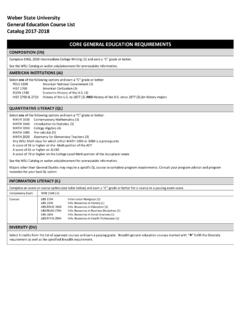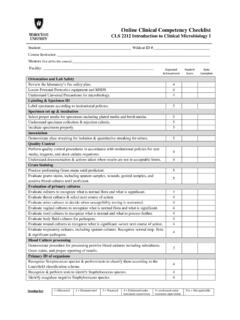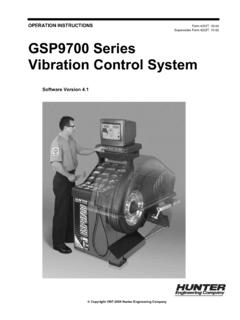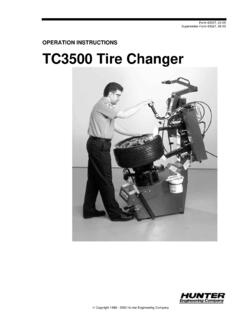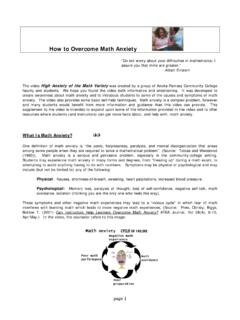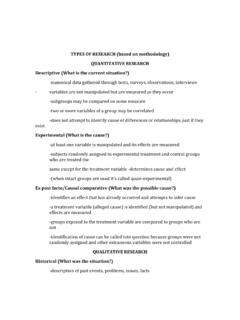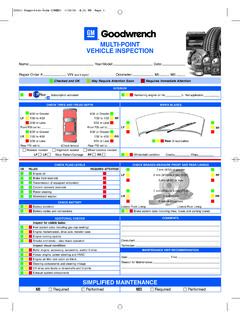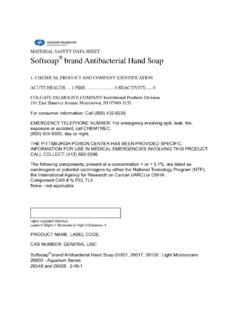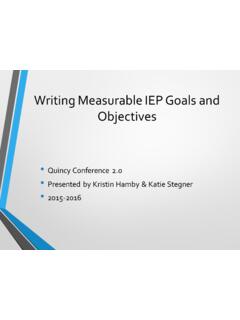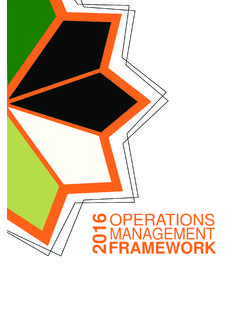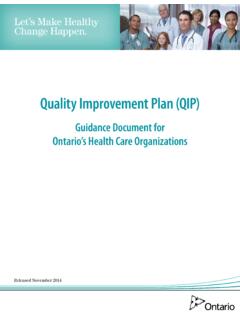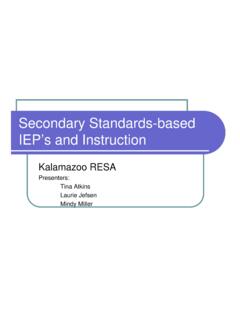Transcription of Tools for Writing Standards-Based IEPs
1 Tools for Writing Standards-Based IEPs CoreCurriculumImprovedStudent Outcomes Standards-Based IEPs A consolidated effort by the Utah State Office of Education, Utah Personnel Development Center, Box Elder, Granite, Jordan, Murray, North Sanpete, and Salt Lake school districts, University of Utah 1 Tools for Writing Standards-Based IEPs Preface 3 Acknowledgement 5 Introduction: Rule and Rationale 6 The Law 7 Definitions 7 Essential Components 8 IEP Membership and Responsibilities 8 Suggested Agenda for an IEP Meeting 10 Foundation of the IEP 11 Present Level of Educational Performance (PLEP)
2 12 measurable annual goals with Objectives/Benchmarks 16 Transition 24 Assessment and Supports 28 Participation in Assessments 29 Special Education Services and Supports 31 Appendices 36 Appendix A: PLEP Worksheets 37 Appendix B: Student Scenarios, Examples, Non-Examples, and Criteria Checklist 40 Appendix C: Additional Transition Examples 50 Appendix D: Frequently Asked Questions (FAQs) 54 Appendix E: Court Cases 58 Appendix F: Trainer Materials 66 References 76 2 P R E F A C E Preface The Tools for Writing Standards-Based IEPs is the result of the work of a task force consisting of classroom and special education teachers, related services personnel, inclusion specialists, administrators, representatives of higher education, and specialists from the Utah State Office of Education and the Utah Personnel Development Center (see Acknowledgement page for a list of the task force members).
3 The purpose of the task force was to determine the content for the development and dissemination of site based and online Standards-Based IEP training which is designed to improve the quality of IEPs based on the standards established by IDEA 97 and Utah s Special Education Rules that will lead to improved student outcomes for all children, including those with disabilities. These rules require that IEPs must address student access to and progress in the general curriculum in the least restrictive environment. The outcomes of the training are as follows: Districts: Learning outcomes of students with disabilities will improve as manifested in classroom performance and on statewide assessments.
4 Implementing useful IEPs should help students with disabilities as a group reach adequate yearly progress (AYP) as defined by No Child Left Behind (NCLB) legislation. Teachers: Utah educators will gain the knowledge and skills necessary to write quality IEPs that address student access to and progress in the general curriculum. Parents: Parents will have meaningful participation in the decision-making processes concerning their children s education. Tools for Writing Standards-Based IEPs is designed to help teachers write IEPs that are compliant and meet the minimum IDEA 97 requirements. Additionally, it is designed to help teachers write IEPs that are also useful: they not only conform to the requirements of the law, but are written so that all parties involved find them understandable and helpful, providing clear roadmaps to increased student outcomes in reaching high standards in the general curriculum.
5 In other words, to have an IEP that another teacher can pick up and implement, and one that is legally defensible. The task force spent many days and countless hours on what would appear to be a relatively simple endeavor just read IDEA 97 and Utah s state rules, and then put together a training packet for districts and teachers. Not so! Early into the process, the task force began to realize this project was not going to be a simple one, so it divided itself into three committees. Each committee worked on separate aspects of the IEP requirements, some of which weremore complex than others, the law Standards-Based IEPs Improved outcomes for students, teachers, districts, and parents.
6 Useful as well as legally defensible IEPs Development of training content NOT AN EASY TASK 3 Acknowledgement PLEPS and student access in LRE measurable annual goals , and short term objectives/benchmarks, struggled. For instance, Writing a PLEP that describes how the student s disability affects his/her performance in the general education curriculum can have many different looks and still be compliant and useful . After reading dozens of PLEPs, goals and objectives, the committee discovered that they can be written many different ways and still be compliant and that there s no one correct way to write a PLEP, goal, or objective as long as basic criteria were met.
7 Much time was spent on determining what the criteria should be. The committee tried very hard not to put requirements on teachers that were beyond what the law intended. This was true for all three committees and the task force as a whole. Another section that required much work was that concerning transition. Addressing transition issues in the IEP was a challenge, as there are no universally accepted standards for a transition curriculum and the state rules and federal regulations are not specific as to requirements. In addition, there were almost as many interpretations of the requirements as there were committee members!
8 The committee members responsible for developing this section of the training relied on publications, practices from other states, and their own experiences to come up with suggestions for developing and Writing IEPs for transition-aged students. The results are intended to provide special educators with a framework for developing transition plans and IEPs that not only meet the requirements, but also meet educators and students needs. The suggested format focuses on the student s preferred outcome for post-school life, blending academics and community and employment experiences in a way that is functional and practical for both the student and educators.
9 The committee that developed the content for the first section, which discusses the essential components of the IEP and the IEP process, worked their material numerous times, and with the help of the task force, developed a model agenda for an IEP meeting. Districts may choose to impose additional requirements for Writing Standards-Based IEPs. IEP forms may vary as will the knowledge base of teachers. Trainings will be individualized according to the wants and needs of individual districts and to the IEP forms they are using. It is expected Tools for Writing Standards-Based IEPs will be helpful in providing practitioners the information needed to writequality IEPs that will serve as meaningful documents leading to improved learning outcomes for students with disabilities.
10 No one right way- just follow criteria Transition: Muddy waters Individualized Training Suggested Agenda for the IEP meeting 4 Acknowledgement All following people have been instrumental in developing the content of A Guide for Writing Standards-Based IEPs. Their willingness to share their time and expertise has been much appreciated. Standards-Based IEP Task Force Sara Andreason Classroom Teacher, Westland Elementary, Jordan District Pat Beckman* Specialist, USOE Kathryn Broughton Special Education Coordinator, Box Elder District Tom Burchett Special Education Director, Salt Lake District Wendy Carver Special Educator, Longview Elementary, Murray District Noelle Converse Coordinator, Granite School District Sally Dyches Special Education Director, North Sanpete District Jackie Harris Transition Specialist, Murray High, Murray District Lisa Holmstead CD Coordinator, Salt Lake District Susan Loving Specialist.
